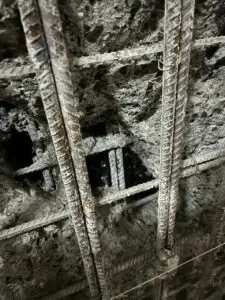CONCRETE COMPACTION IS A MUST
 Concrete is not as simple as it may seem as there are over 3000 mix designs in Australia alone. Each time you add, remove, or substitute an ingredient, or even pour in different weather conditions will give you very different results. Therefore, your concrete supplier must test the concrete mix design to understand its performances in compression, shrinkage, initial setting time, % of permeable voids, density, etc, if they have not already done that. This is to better understand how your concrete mix will perform based on your project requirements, particularly under hydrostatic pressure, in splash zones, in the presence of chemicals such as chloride and Sulphate, high concentrations of carbon monoxide and dioxide, etc.
Concrete is not as simple as it may seem as there are over 3000 mix designs in Australia alone. Each time you add, remove, or substitute an ingredient, or even pour in different weather conditions will give you very different results. Therefore, your concrete supplier must test the concrete mix design to understand its performances in compression, shrinkage, initial setting time, % of permeable voids, density, etc, if they have not already done that. This is to better understand how your concrete mix will perform based on your project requirements, particularly under hydrostatic pressure, in splash zones, in the presence of chemicals such as chloride and Sulphate, high concentrations of carbon monoxide and dioxide, etc.
Once the above is covered, your journey is not finished yet. On top of the ambient temperature pouring limit and the concrete max temperature, you must check the slump on-site at the pump every 50m3, then assess the plane of the structure to be poured (Vertical or horizontal). The vertical structures could be very challenging to pour without trapping the air bubble, therefore, it is highly recommended to vibrate every 300mm layer from the bottom up, unless you are using SCC concrete.
If unsure of the correct method of vibrating your concrete, refer to:
NCC 2022 – Part 3.2.3 Concrete and reinforcing
CCAA – Part V. Concreting Site Practices – Handling & Placing.
CCAA – Part V. Concreting Site Practices – Compaction.
For more accurate and elaborated information, refer to TfNSW B80 – Concrete Work For Bridges.
Without doing the above, your waterproofing system will be a waste of money and time when applying it over large honeycombing. Let alone the durability of the concrete and the structure, hence the sustainability of the project.
Do it right today for a better tomorrow.














